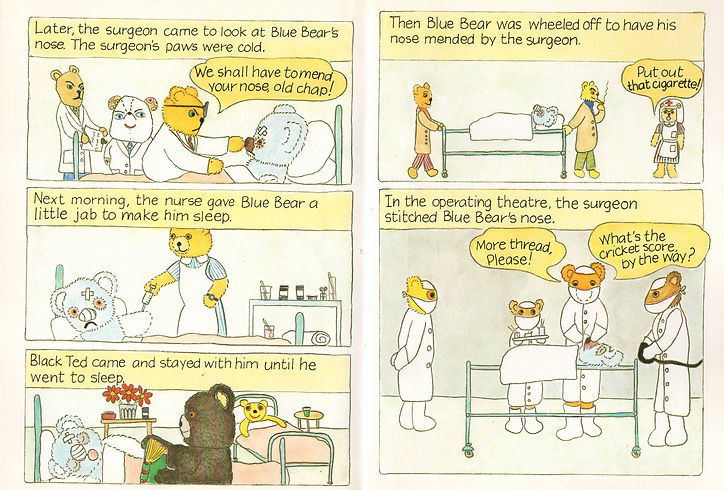Teddy Tales
Hugh drew and painted his childrens' various bears: his pictures were seen by his brother-in-law Sebastian Walker who had just started his children book publishing company Walker Books. He commissioned Hugh to write and illustrate the four books which became Teddy Tales.








Hugh & C.S. Lewis: Imaginary Worlds
Both Hugh and the famous author C.S. Lewis when they were young, created imaginary worlds of animal stories.
As a schoolboy Hugh met Lewis in Oxford. Hugh's daughter Stella created a book containing their correspondence, illustrated with photographs and some of Hugh's childhood drawings.





Below is a selection of images from 'Indesing'. Click on any of the squares below to see a larger version:










Copies of the letters from C.S. Lewis:


Here are the letters transcribed from C.S. Lewis to Hugh
First Letter
All Saints Day 1953
Dear Hugh,
Thank you very much. I know much more than I did and feel I have made a good start in Indesingian history. King Hidvom is my favourite: I think he was rather like me (in character I mean: perhaps in appearance too). I was not at all surprised when BestarI went mad: I don’t hold with bears (or humans) who are always founding and inventing things. And can’t at all take Olav Funk’s view of this meddling monarch indeed I feel more friendly to poor Bestar II and his weakness for turtle soup (not that it is a soup I like very much myself, I would rather have a kidney or mushroom or even tomato). The best of these ancient portraits is that of the wily King Wilhelm IV. One can see the wiliness in his face.
Of course there is a great deal more to be known for which (I suppose) I must go to more advanced studies by such scholars as Funk and Formid . The annalist (as one would expect) confines himself wholly to kings lives and military history. His interest in constitutional developments is so slight he does not tell us the contents of the (surely an important instrument!) nor whether a “sacking” of a king (see coff) was the same as deposition and whether it needed a rebellion or whether it could be done by law. Nor does he explain the joint rein of Metre and Gram. More than one king at once is certainly an arrangement that can be founded in other countries; e.g Atlantis (at the period when Cyril, Anthea , Robert , Jane and the learned Ji-Jimmy visited it) (5 Children and It) Sparta; and Narnia. But the annals do not make clear how it came just once in Indeseng and why was never tried again (perhaps because the rein of Metere and Gram was so dull or because Gram’s book was so bad?)
Never the less as some critic has probably said “The Annals despite their brevity and their strict limitations of scope, bear every where the stamp of truth, and are an indispensable source for all future historians, while the vigour and simplicity of their style will in all ages make them a delight to the general reader.”
I send you the history of another country which perhaps might have been the same mould as Indesing. When India was mentioned in this History it does not mean, India of our world. It was exactly the same shape but instead of joining into Asia, as it was an Island with its northern coast running around the north of the Himalayas, like this:
(Simple out line of India)
As you see, this history does not come down to modern times like the Annals of Indeseng: but even then it tells you rather more about each rein,
Yours Ever,
C.S. Lewis
Sorry I’ve no map (there were maps) of Animal Land and other lands mentioned (like Pigland, Rabbit land etc) Even in that one Island like countries in England. No hurry about returning the book
Second Letter
Nov 26th 1953
Dear Hugh,
You say you send a quarterly Historians paper but, hang it, you don’t.
I think my brother and I in those days said that if a rabbit married a mouse some of the children might be rabbits and other mice, no funny little mabbits or rice as I suppose would really happen.
Torfi’s (in Boxen his own book) wicked plan a notorious lantern act was to put such a terrific tax on lamps that the barges would have to do without lights at all and there would be collisions and wrecks and so the river would gradually be cleared.
I wait for a quarterly paper with great interest. The literary, history will be especially in my line. (Dates never were).
Yours,
Jack Lewis
Third Letter
(after Hugh sent the 2nd piece of work)
Dec 5th 1953
Dear Hugh,
- Thank you for the interesting specimens of Indesingian literature and other documents. I see it had its ups and downs like other literature. Junka belongs to the age of plain heroic prose, as I hope there is more of him (or of his period) still to be published. Koff of course belongs to the history of science: literary charms are hardly to be expected of him. The mid thirteenth century marks a decline, having little to offer but what one would call journalism. Kunk, in spite the barbarity of his sentiments, has a certain vigour. But all this pales into insignificance beside the lyrical impulse of Gram (I can’t help thinking the old edition have got the 8th line of his anthem wrong. Did it not end the “foaming bore instead” of “wild boar”?) Of the more satirical poets I think Formit was the better - he goes with a swing. I got more and more pro Elephant as I went on. I feel most of things said against them are lies. The Indians were brown men, like Indians of our world.
My term is over don’t you wish yours was.
Yours,
C.S. Lewis

